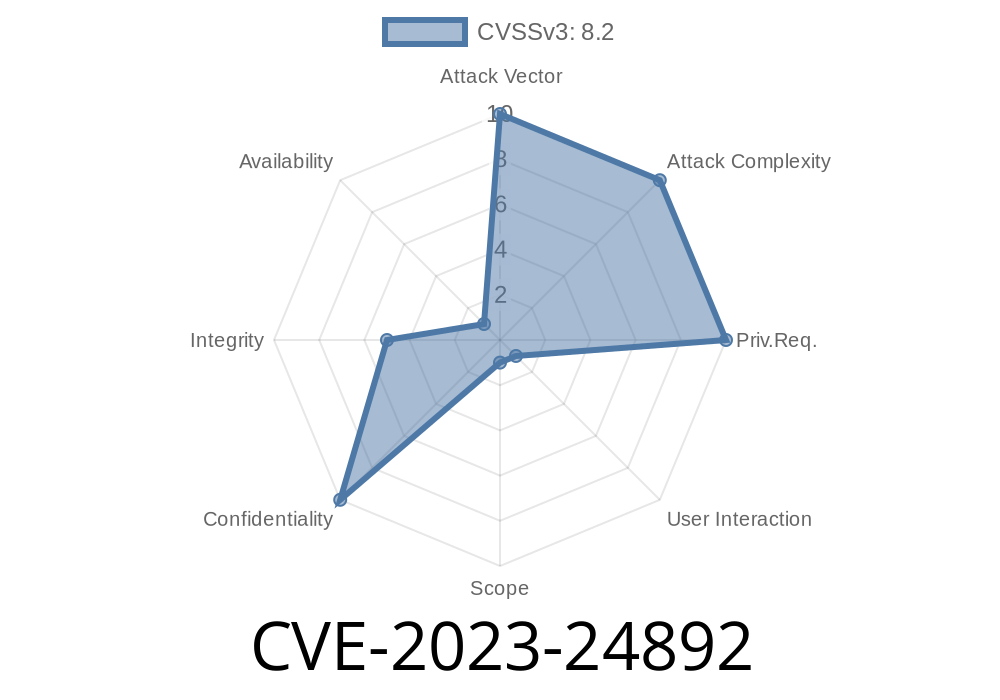A browser spoofing vulnerability has been identified in Microsoft Edge's Chromium-based WebView2 component. Designated as CVE-2023-24892, the vulnerability is particularly concerning as it can be easily exploited, allowing threat actors to manipulate users and execute phishing attacks. This post will delve into the technical details of CVE-2023-24892, including the underlying issue, how it can be exploited by attackers, and potential mitigation strategies.
Vulnerability Background
Microsoft's WebView2 is an essential component for embedding web technologies and rendering web content inside native applications. It is built upon the Chromium-based Edge browser, providing numerous features and capabilities to application developers. The vulnerability CVE-2023-24892, which lies at the heart of this component, allows attackers to spoof URLs and trick users into believing that they're visiting legitimate websites, while they are actually being redirected to a malicious site.
The technical details of this vulnerability have been published in the following sources
1. Microsoft's official security advisory
2. NIST's National Vulnerability Database (NVD) entry
3. Exploit Database entry
Code Snippet
Below is a sample code snippet demonstrating how to exploit the vulnerability. This code creates a WebView2 instance and enables the attacker to spoof the URL:
#include <iostream>
#include <string>
#include "WebView2.h"
using namespace Microsoft::Web::WebView2::Core;
int main()
{
WebView2EnvironmentOptions options;
options.AdditionalBrowserArguments = L"--disable-web-security";
options.Language = L"en-US";
auto environment = WebView2Environment::CreateAsync(options).get();
auto controller = environment->CreateCoreWebView2Controller().get();
controller->Navigate(L"https://www.example.com";);
controller->WebMessageReceived += [](IInspectable* sender, CoreWebView2WebMessageReceivedEventArgs* e)
{
std::wstring message;
e->TryGetWebMessageAsString(message);
// Process the message and send the user to the spoofed URL
controller->Navigate(L"https://www.malicious-site.com";);
};
// More code for setting up a WebView2 instance...
return ;
}
Exploit Details
The attacker can initiate a WebView2 instance using the --disable-web-security command-line flag, which essentially disables the Same-Origin Policy (SOP) and Cross-Origin Resource Sharing (CORS). With these security restrictions lifted, the attacker has a greater ability to control the WebView2 instance and intercept its navigation events.
Once navigation events are intercepted, the attacker can use the WebMessageReceived event to communicate with the malicious site and send the user to the spurious URL. As the WebView2 component appears legitimate to the user, the unsuspecting victim has no reason to doubt the authenticity of the seemingly genuine website.
Several potential options to protect against CVE-2023-24892 include
1. Update WebView2: Ensure that your WebView2 component is up-to-date. Microsoft consistently releases security updates that can help mitigate emerging vulnerabilities.
2. Monitor command-line flags: Closely monitor any command-line flags being passed to WebView2 components, especially those that can weaken security settings.
3. Validate navigation events: Implement navigation event validation when using WebView2. This could involve verifying that the navigation target matches the intended destination.
4. Use content security policies: Implement Content Security Policies (CSP) to provide an additional layer of protection against potential spoofing attacks.
Conclusion
CVE-2023-24892 is a significant vulnerability with the potential to compromise Microsoft Edge's Chromium-based WebView2 component by spoofing URLs. Developers, system administrators, and everyday users must remain vigilant and keep WebView2 instances up-to-date while ensuring secure configurations. By implementing the suggested mitigation strategies, it is possible to minimize the potential impact of this vulnerability and maintain a secure browsing experience within native applications.
Timeline
Published on: 03/14/2023 17:15:00 UTC
Last modified on: 05/09/2023 18:15:00 UTC
